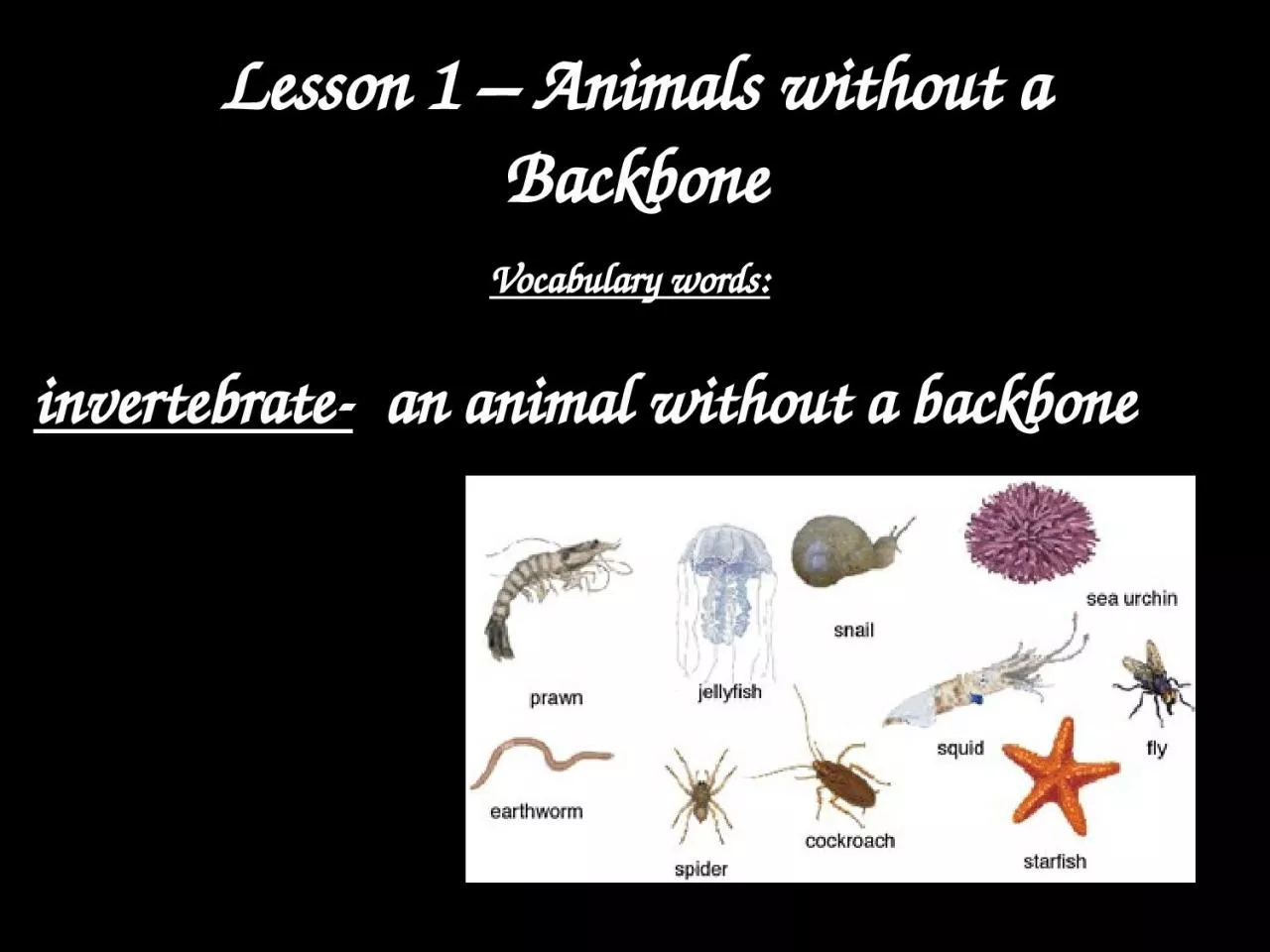

Vocabulary words invertebrate an animal without a backbone Vocabulary words sponge a simple invertebrate that has a hollow body with a single opening and lives in water Lesson 1 Animals without a Backbone ID: 919024
Download Presentation The PPT/PDF document "Lesson 1 – Animals without a Backbone" is the property of its rightful owner. Permission is granted to download and print the materials on this web site for personal, non-commercial use only, and to display it on your personal computer provided you do not modify the materials and that you retain all copyright notices contained in the materials. By downloading content from our website, you accept the terms of this agreement.
Slide1
Lesson 1 – Animals without a Backbone
Vocabulary words:invertebrate- an animal without a backbone
Slide2Vocabulary words:
sponge- a simple invertebrate that has a hollow body with a single opening and lives in water
Lesson 1 – Animals without a Backbone
Slide3Vocabulary words:
cnidarian- an invertebrate with stinging cells on the ends of tentacles.Lesson 1 – Animals without a Backbone
Slide4Vocabulary words:
mollusk- an invertebrate that has a soft body and a shellLesson 1 – Animals without a Backbone
Slide5Vocabulary words:
echinoderm- a spiny skinned invertebrateLesson 1 – Animals without a Backbone
Slide6Vocabulary words:
endoskeleton- an internal supporting structureLesson 1 – Animals without a Backbone
Slide7Vocabulary words:
arthropod- an invertebrate with jointed legs, a body that is divided into sections, and an exoskeletonLesson 1 – Animals without a Backbone
Slide8Vocabulary words:
exoskeleton- a hard covering that protects the bodies of some invertebratesLesson 1 – Animals without a Backbone
Slide9How do animals differ?
1. Symmetry- some animals have symmetry while others do not.
Lesson 1 –
Animals without a Backbone
Slide10Backbon
e or no backbone- 95% of all animals do not have a backbone (they are invertebrates). Lesson 1 – Animals without a Backbone
Slide11What are some invertebrates?
Lesson 1 – Animals without a Backbone
Slide121. Sponges -They do not have symmetry
-They live underwater.Lesson 1 –
Animals without a Backbone
Slide131. Sponges
Lesson 1 – Animals without a Backbone
Slide142. Cnidarians -Jellyfish and Corals
-Use stinging cells to stun prey.Lesson 1 –
Animals without a Backbone
Slide152. Cnidarians
Lesson 1 – Animals without a Backbone
Slide163. Mollusks -Snails and Slugs are the only ones to live on land.
-Clams, oysters, squid, and octopi are examples.Lesson 1 –
Animals without a Backbone
Slide173. Mollusks
Lesson 1 – Animals without a Backbone
Slide184. Echinoderms -Sea Urchins
-Have an endoskeleton
Lesson 1 –
Animals without a Backbone
Slide194. Echinoderms
Lesson 1 – Animals without a Backbone
Slide205. Arthropods -This is the largest invertebrate group.
-Crabs, shrimps, insects, and spiders are some examples.Lesson 1 –
Animals without a Backbone
Slide215. Arthropods
Lesson 1 – Animals without a Backbone
Slide226. Flatworms
-They have flat bodies -They are the simplest worms. -Some live inside of other animals.
Lesson 1 –
Animals without a Backbone
Slide236. Flatworms
Lesson 1 – Animals without a Backbone
Slide247. Roundworms
-They have thin bodies with pointed ends. -Most live inside of other animals.
Lesson 1 –
Animals without a Backbone
Slide257. Roundworms
Lesson 1 – Animals without a Backbone
Slide268. Segmented Worms
-Earthworms, sandworms, and leeches are examples. -Most live on land.
Lesson 1 –
Animals without a Backbone
Slide278.
Segmented Worms
Lesson 1 –
Animals without a Backbone